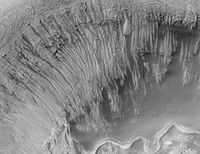Newton (Martian crater)
| Martian crater Newton | |
|---|---|
 Gullies inside a small crater within Newton Crater | |
| Planet | Mars |
| Coordinates | 40°48′S 201°54′E / 40.8°S 201.9°ECoordinates: 40°48′S 201°54′E / 40.8°S 201.9°E |
| Diameter | 298 km |
| Eponym | Sir Isaac Newton |
Newton is a large crater on Mars, with a diameter close to 300 km. It is located south of the planet's equator in the heavily cratered highlands of Terra Sirenum. The impact that formed Newton likely occurred more than 3 billion years ago. The crater contains smaller craters within its basin and is particularly notable for gully formations that are presumed to be indicative of past liquid water flows. Many small channels exist in this area; they are further evidence of liquid water.
The crater was named in 1973 in honour of Sir Isaac Newton.

In 2011 it was announced that images captured by NASA's Mars Reconnaissance Orbiter have suggested the presence of possible flowing water during the warmest months on Mars, as shown in images taken of Newton Crater and Horowitz Crater among others.
-
Channels on the floor of Newton Crater, as seen by THEMIS. Click on image to see relationship of Newton to other nearby craters.
-

Gullies near Newton Crater, as seen by HiRISE under the HiWish Program.

